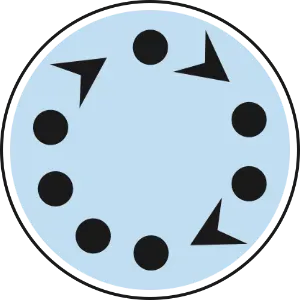Use 1–2–4-All.
If you are not familiar with Liberating Structures, I suggest you take a look at them. I use a few of them now and then as circumstances warrant. In future articles, I will discuss some of the others, but today’s installation is dedicated to the Liberating Structure I most often use — 1–2–4-All.
Through this technique, a group, almost no matter how large, can generate and collaborate on ideas in a relatively short period of time. The technique is often touted as helpful for groups that are unfamiliar with each other — such as a conference session audience or a newly formed team. And while I agree, I don’t think that is the primary benefit of the technique. In my opinion (and experience), the primary benefit of the 1–2–4-All technique is that it helps all voices be heard. And while this is helpful in impromptu groups, it is sometimes more helpful in teams that, in fact, do know each other quite well.
The mechanics are fairly simple.
It starts with an identified problem or a proposed solution. Folks start by working individually, then in pairs, then in quads, and finally as a whole group.
Individual work is done for one minute. Instruct folks to record their responses. In person, I tend to use post-its or loose leaf paper. On-line, I tend to ask folks to use whatever works best for them.
Ask an open-ended question to the group that relates to the problem or proposal. Questions focused towards action or solution are usually most productive. For example, “How might you handle this issue?” or “What actions would you recommend?”
At the end of the minute, have folks organize into pairs. This gets a little complicated on-line. If you have access to something like gather.town, it is easier or if you can use rooms in Zoom and allow folks to self-select.
As pairs, they have two minutes to generate new ideas based on their prior ideas.
Pairs then form into groups of four where they have four minutes to look at the ideas generated thus far, identify similarities and differences, and select (or come up with) one or two key ideas.
In the final round (All), each team of four shares their key ideas.
You may have noticed that the ending of this process is not the selection of an idea, but merely the presentation of ideas after generation, evaluation, and coalescence.
“How is that, in any way, useful?”, you might ask.
In a future article, we’re going to talk about Opportunity Solution Trees. Until then, let’s agree that having options for every problem can prove helpful. Being able to evaluate one potential solution against another can help us think more deeply about both options. And if the course we choose to pursue does not prove to be progressing us toward the desired outcome, we have some well considered and potentially well vetted alternative paths at the ready.
If you want early access to these articles, come on over to https://docondev.substack.com/ where I’ll be publishing articles a month or two ahead of other platforms.


